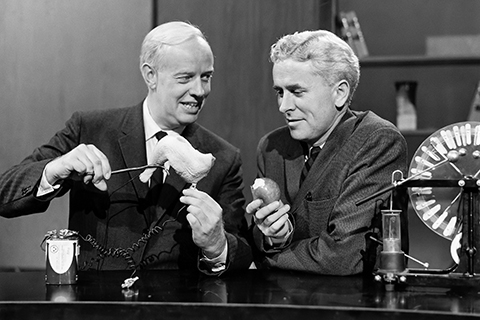J.N. Patterson “Patt” Hume, who died last May at the age of 90, not only witnessed the rise of the Information Age – he actually helped create it.
As a U of T student in the 1940s, Hume (BA 1945 UC, MSc 1946, PhD 1950) spent agonizing hours performing complex physics functions using hand-cranked calculators. All that changed in 1952 when he was a physics prof, and the university purchased a hulking Ferranti computer. Canada’s first electronic computer, Ferut (as it came to be known), cost upwards of half a million dollars and broke down constantly. But it was to revolutionize Hume’s career.
Alongside project assistant Beatrice Worsley, Hume created software known as Transcode for the curious new machine. One of the earliest computer languages, it paved the way for better-known successors such as Fortran and Java. It also enabled Hume to direct the world’s first long-distance use of a computer (he used Ferut to process research data from the University of Saskatchewan, then sent the calculations back by teletype).
In 1964, Hume was one of three physicists who founded the computer science department at U of T; he was chair from 1975 to 1980. “But long before there was a department, we taught computer courses, including a non-credit course at night school – to actuaries and insurance people, mostly,” recalled Calvin “Kelly” Gotlieb, a fellow computing pioneer and the department’s first chair. Gotlieb and Hume began to write extensively on the burgeoning subject, and the pair ultimately coined 11 terms that are now in the Oxford English Dictionary (the most famous is “loop”). In the end, Hume wrote or co-wrote some 19 books; his textbooks on computer science are still used by high school students today.
Physics, however, was Hume’s first love, and making the subject accessible was a huge part of his life’s work. In 1960, he and fellow U of T physicist Donald Ivey complemented their teaching careers by becoming the first hosts of CBC’s long-running The Nature of Things. Their approach was hilarious, all the more so for their buttoned-down “professorial” appearance. The pair demonstrated natural laws by popping balloons, hurling paper airplanes and devising wacky camera tricks.
Hume, who also served as master of Massey College in the 1980s, had an unusual ability to translate complex new ideas, and inspired generations of students to embrace the once intimidating world of computers. Says Sven Dickinson, current chair of U of T’s computer science department: “Professor Hume made an indelible mark on computing in Canada and beyond. His work focused on creating the programming and operating systems that allowed computers to become everyday tools, paving the path for computer science’s universal role in the world today.”
Recent Posts
U of T’s 197th Birthday Quiz
Test your knowledge of all things U of T in honour of the university’s 197th anniversary on March 15!
Are Cold Plunges Good for You?
Research suggests they are, in three ways
Work Has Changed. So Have the Qualities of Good Leadership
Rapid shifts in everything from technology to employee expectations are pressuring leaders to constantly adapt







One Response to “ In Memoriam: J.N. Patterson Hume ”
This article brought back some pleasant memories. In 1952, as a 17-year-old chemical engineering freshman, I started some lecture days not in the engineering department but in P105, the beautiful lecture theatre in the old Physics Building. There, Dr. Hume entertained and educated me. His “Defying Death” lecture (inherited from the then recently retired Professor Satterly) still stands out in my mind as a pinnacle of tutelage. It must have been effective, for I pulled off a 105% in the first-term physics examination, a performance I never matched subsequently in any other subject.
Dr. Hume’s lecture was the first one of the day for my class, but nobody was late after he demonstrated a bravura memory feat. At the third lecture, after only one laboratory session in which Dr. Hume could have had an opportunity to meet the 150 students in my class, he greeted a latecomer by name, and thanked him for arriving before the end of the lecture.
At my tender age, Dr. Hume seemed like an ancient. Now I realize that he was only 12 years older than I, and had earned his doctorate only two years earlier.
James E. Luce
BASc 1956
Warwick, New York